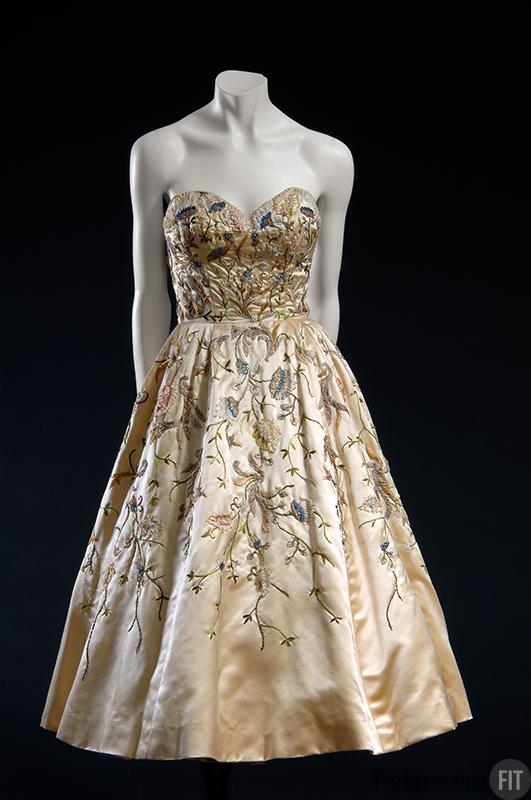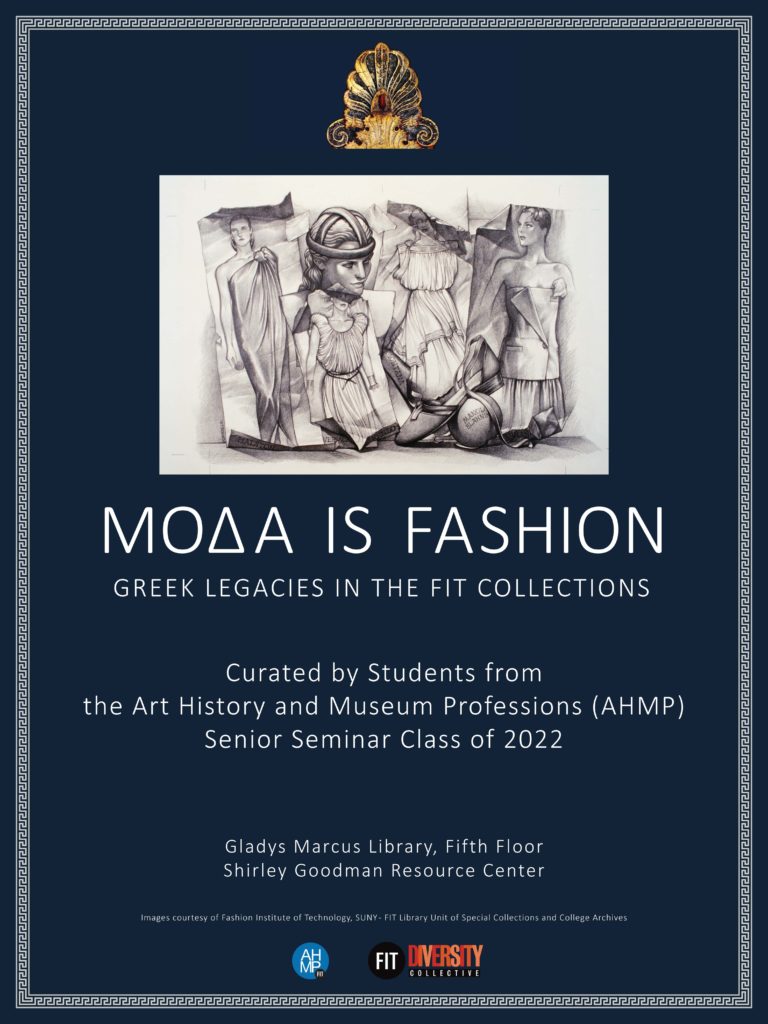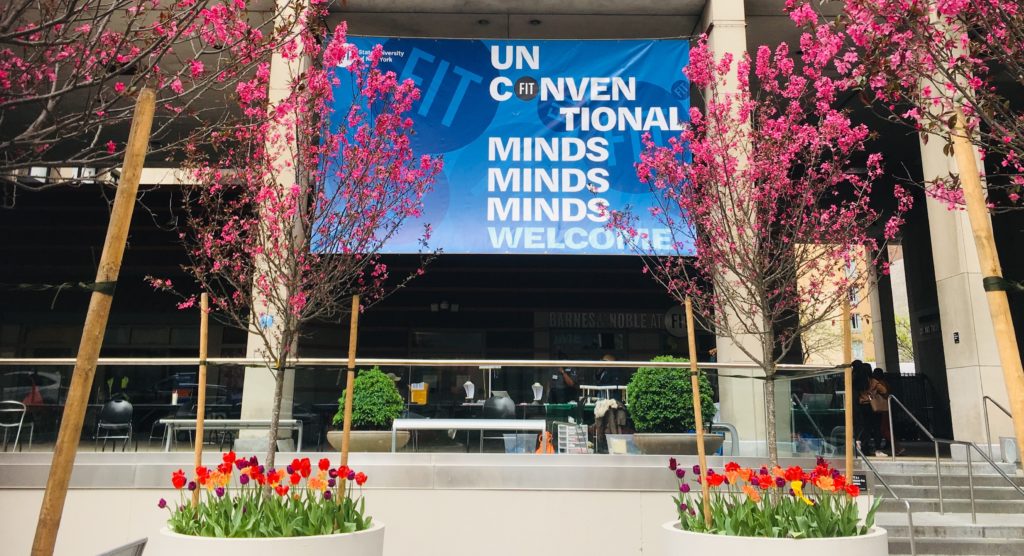By Frida Loyola, Sunday, March 20, 2022
This essay is written as an assignment for the AHMP senior class “Exhibitions” project ΜΟΔΑ IS FASHION. The exhibition is on display at the State University of New York’s FIT campus Gladys Marcus Library in Spring and Summer 2022.
A type written letter with her hand written signature, sent by Despina Messinesi (1911–2003) to Thomas Drew at the Galleries at FIT on March 23, 1975, is preserved in accession files with The Museum of FIT. The letter informed Drew about the original whereabouts of the ensembles she had just donated. These ensembles included a New Look 1951 dress by Christian Dior and a 1955 Jean Dessès chiffon.

Like something out of an Audrey Hepburn movie. (Stephen Miller 2003).
From a 2003 obituary and other archival documents preserved, we learn that she was born as Despina Georgia Plakias to Greek immigrants from Ioannina in a suburb of Boston in 1911. She lost her father at the age of 11.

An early photograph shows the 18 year old Despina dressed up as Monsieur Beaucaire for a student theater play at Abbot Academy in Andover, MA. Based on a 1900 novel, the novel gained new fame in a silent movie with Rudolph Valentino in 1924 which in turn served as the inspiration for the play. The Andover Townsman from June 7, 1929 described Despina’s performance as “outstanding …[…]… With charm of voice, expression and manner, her Beaucaire dominated every situation with a simple, easy grace.”
In the same summer of 1929, Despina traveled to Greece, visiting her grandmother. Here she met her future husband, the wealthy Greek shipping magnate Miltiades Leon Messinesi (born 1895), and got married. Messinesi’s father was a former General Consul in London. According to a news feature submitted by Despina’s brother John Plakias to the New York Times in 1931 she began living in Athens in Greece around the same time. During these years, she continued to travel and began to work as a fashion reporter in Paris.
As Artemis Leontis has shown in her brilliant biography of the American Hellenophile Eva Palmer Sikelianos (1874–1952), the 1930s brought a new wave of great interest in Greek fashion to New York City. The city was excited about Greek fashion. Thanks to a friendship with curator Gisela Richter, the Metropolitan Museum of Art featured an exhibition on Palmer Sikelianos’ fashion creations in the summer of 1937, and two years later the Greek government lent a number of original ancient Greek sculptures to the World’s Fair in Queens in New York City.
During all these years, Despina “Madam Milto Messinesi” traveled back and forth between Athens, London, Paris and New York. She moved back more permanently to New York City in 1941, and began to work for Vogue shortly thereafter. A funny story relates to her first day at work in April 1941 and was described by the biographer of her obituary as follows:
Hired at $25 a week, she actually took off her first day of work in order to run a publicity stunt for Greek war relief, leading a herd of flower-bedecked donkeys through New York’s streets and to the Ritz. Coming into the Vogue offices the next morning, she was surprised to find that everyone seemed to know her already. Then she learned why: A half-page photo of her hugging a donkey had appeared in that morning’s paper.
Photographs from the event at the Ritz Carlton Hotel are preserved. I was able to identify and read most of her Vogue articles and collected information on the dresses she donated to the FIT Galleries. In her own voice she introduces herself as a “little shop-hound, size 10,” to the Vogue readers in April 1944.
Over the next decades, she became Vogue‘s main fashion editor, traveling places far and wide. During these decades, she became known for her sense of elegance. Ensembles owned by The Museum at FIT today including the black dress 77.17.3, possibly by fellow Greek diaspora designer Jean Dessès, a silk satin with polychrome ribbon, silk floss embroidery, and rhinestones by Christian Dior 1951 (75.86.5), or dress 81.232.1 by Christian Dior New York 1954 were part of her fashionable wardrobe, and made her indeed appear like out of an Audrey Hepburn movie.

Vogue featured her work on the royal Greek family, and several travel stories, sometimes from Greece, are part of her oeuvre. Today, The Museum at FIT and The Metropolitan Museum of Art house Messinesi’s donations. Her dresses are as diverse as fascinating and include a pair of American underwear pants from 1916, a fine woolen dress by French fashion designer Emanuel Ungaro (1933–2017) from the late 1960s and others. The voice of her writings for Vogue remains in FIT’s Library periodical collections. And the rest, as they say, is history.
Further Reading
Leontis, Artemis. 2019. Eva Palmer Sikelianos: A Life in Ruins. Princeton: Princeton University Press.
Miller, Stephen. 2003. Despina Messinesi, Long Time Editor at Vogue, 92. Obituary, July 2003.
O’Shea Borrelli, Laird. 1997. “Dressing Up and Talking about It: Fashion Writing in Vogue from 1968 to 1993,” Fashion Theory 1.3 (1997), 247–59.
About the Author

Frida Loyola enrolled in the AHMP program after attending the Pink symposium in 2018 at the Museum at FIT. She plans to blend her design experience with Museum Studies and work as a Fashion Historian.
Current Favorite Reading or Art Exhibition
One of my favorite, and recent, exhibitions was The Salem Witch Trials: Reckoning and Reclaiming at the Peabody Essex Museum. The trials serve as an example of injustice and intolerance in our country’s history and remind us that history can indeed repeat itself.


